Unit 6 I'm watching TV. Section A 1a-2d 课件(共82张PPT)
文档属性
| 名称 | Unit 6 I'm watching TV. Section A 1a-2d 课件(共82张PPT) | 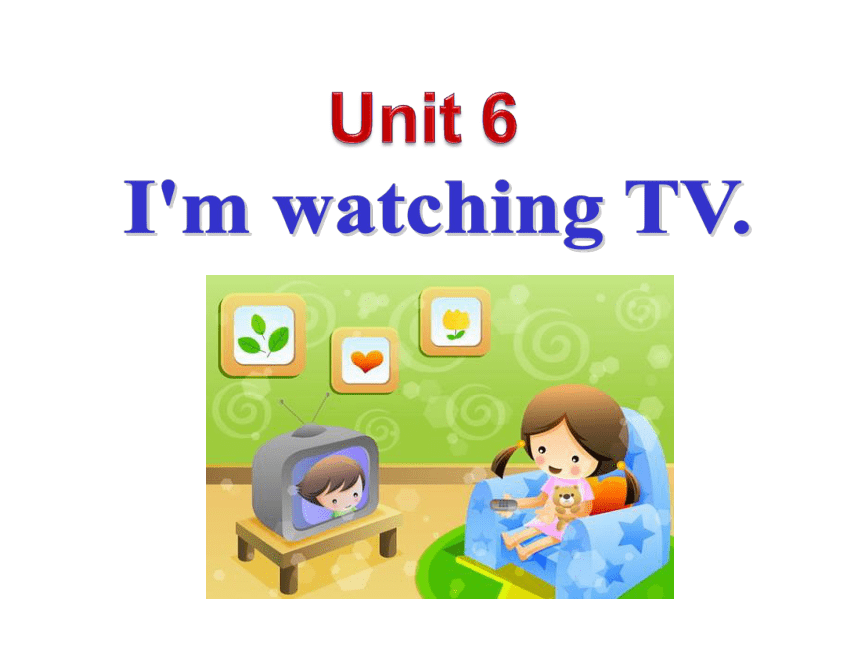 | |
| 格式 | ppt | ||
| 文件大小 | 7.3MB | ||
| 资源类型 | 教案 | ||
| 版本资源 | 人教新目标(Go for it)版 | ||
| 科目 | 英语 | ||
| 更新时间 | 2021-08-07 07:01:33 | ||
图片预览


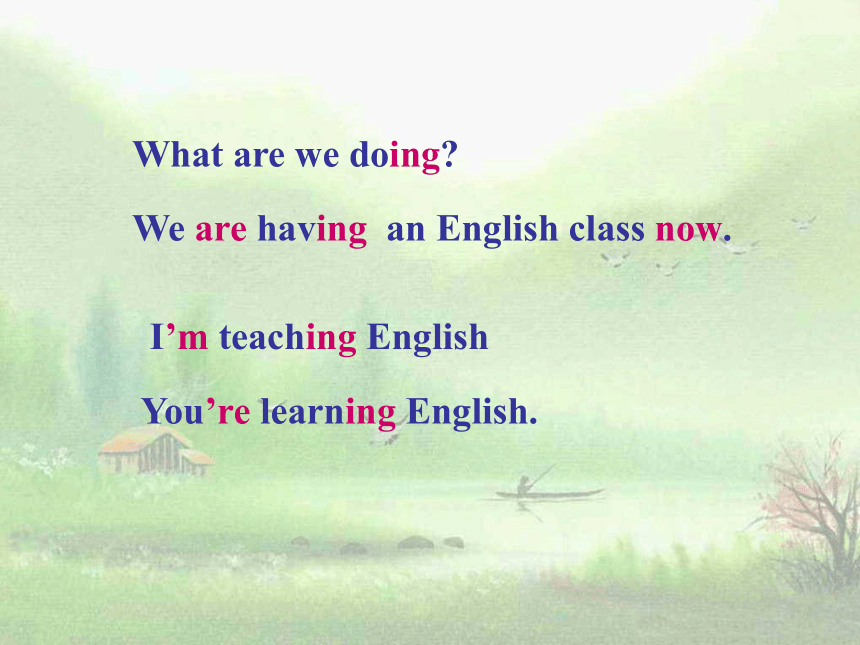
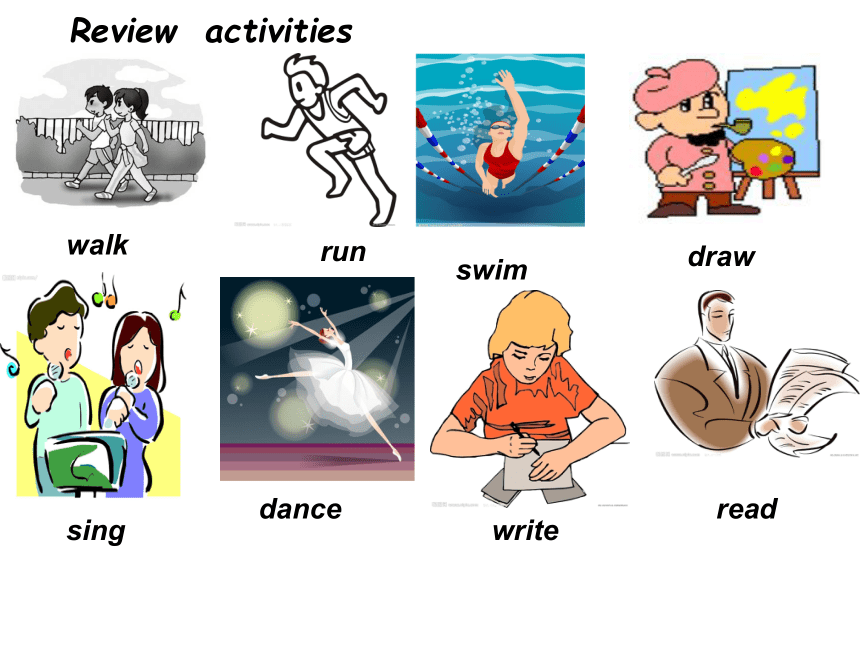

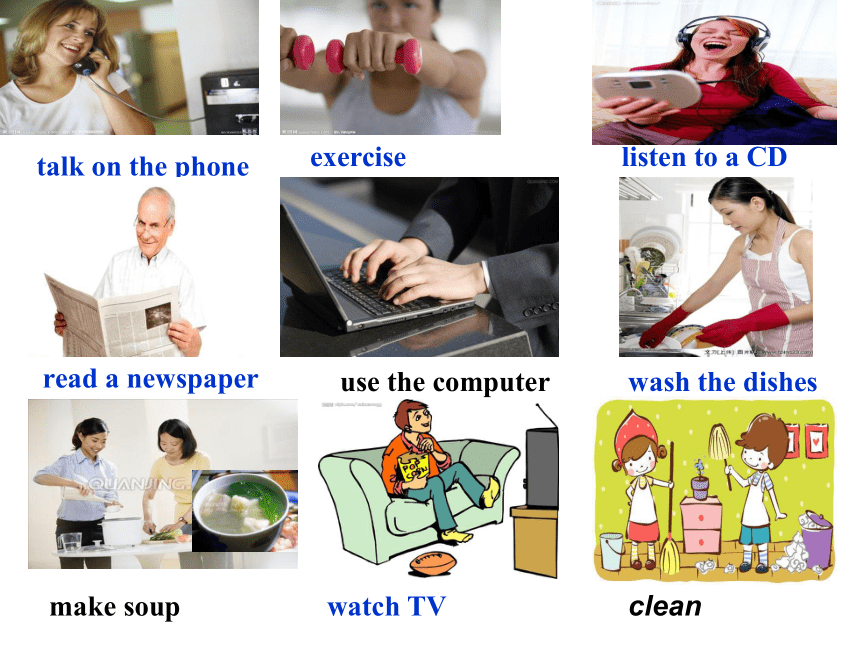
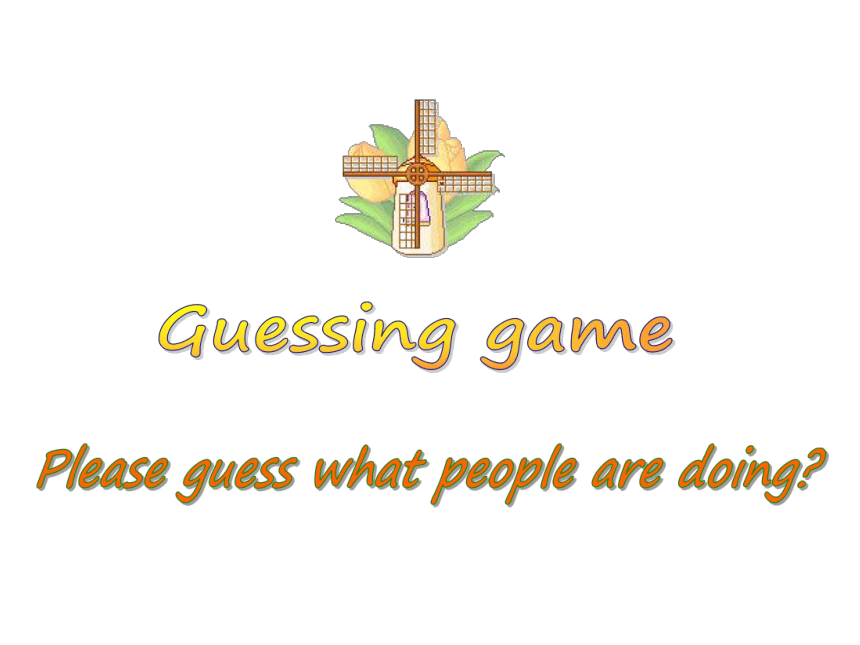
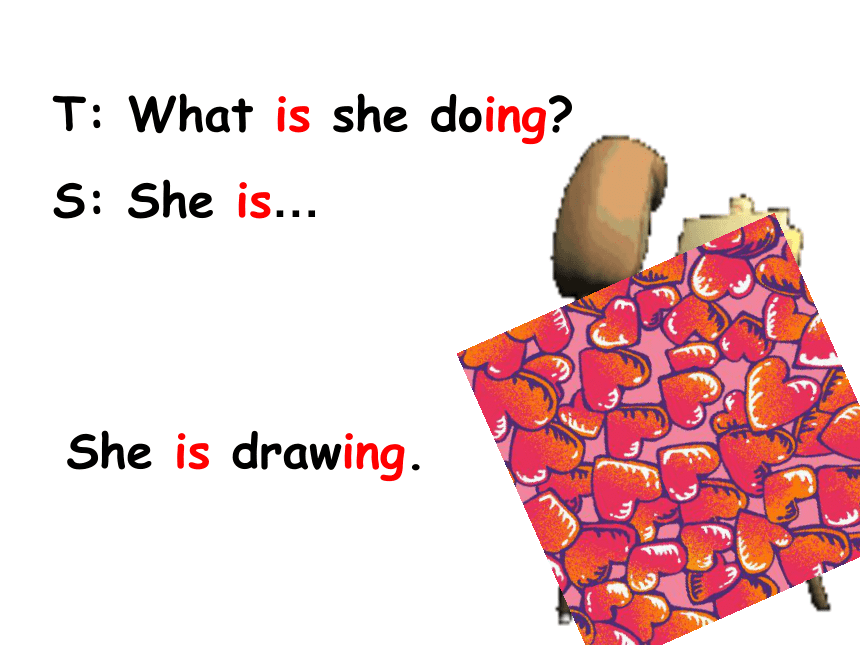
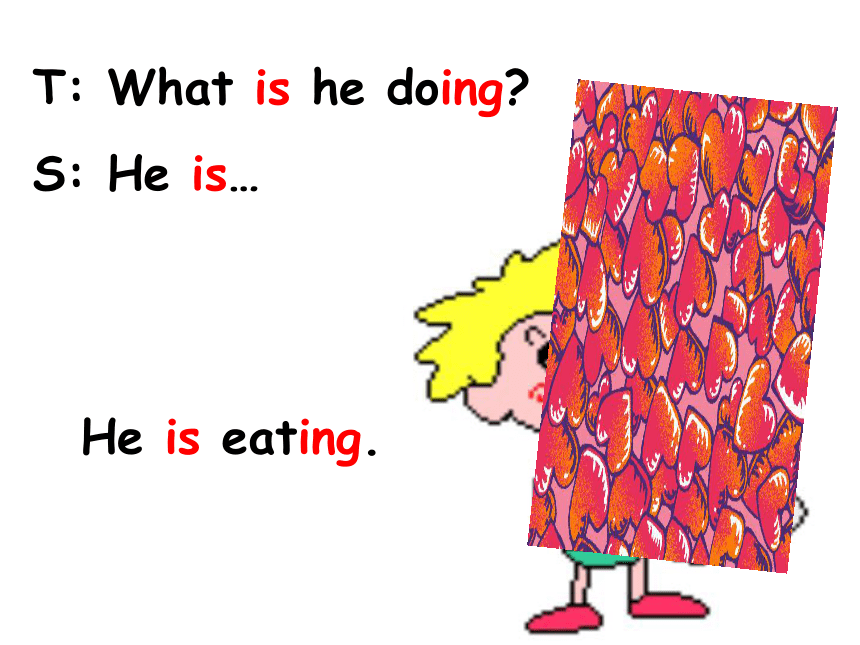
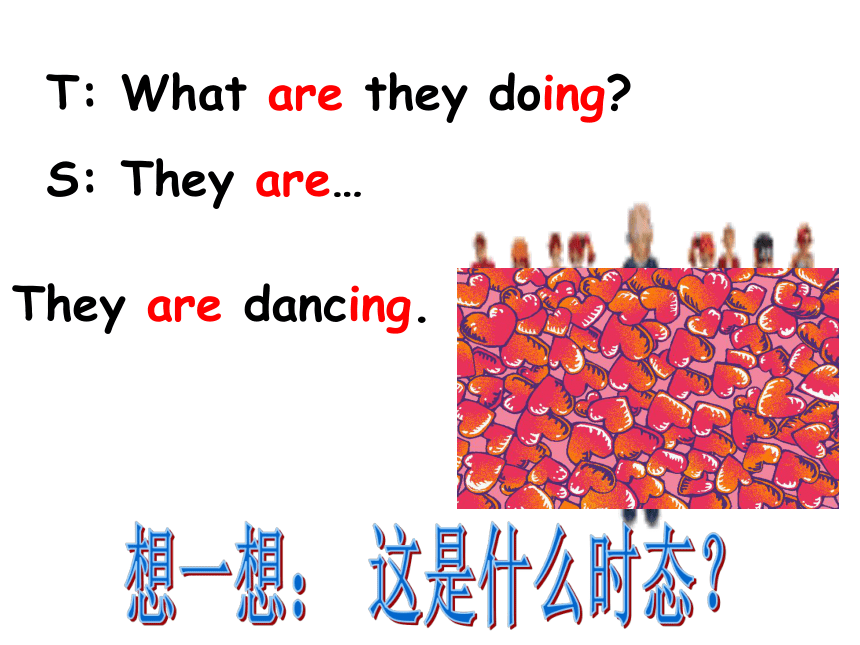
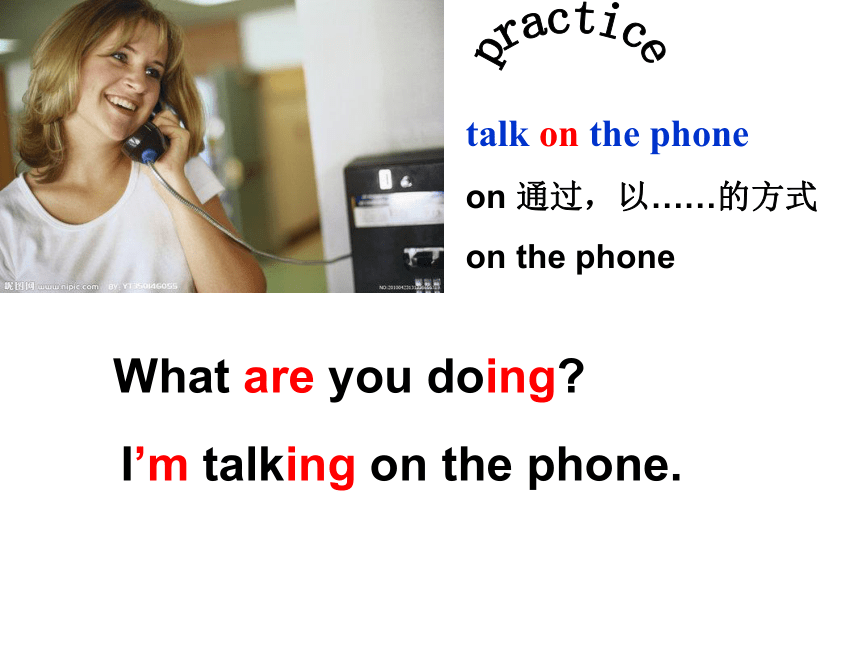
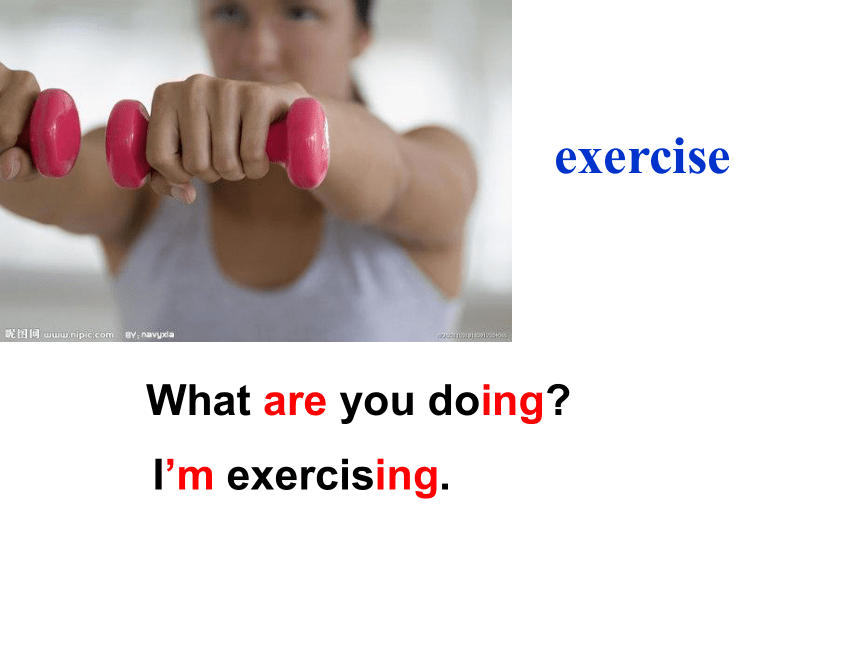
文档简介
Section A
Period One
What are we doing?
We are having an English class now.
I’m teaching English
You’re learning English.
Review activities
walk
run
swim
draw
sing
dance
write
read
play the guiter
paly basketball
play computer games
watch TV
wash
clean
talk on the phone
exercise
listen to a CD
read a newspaper
use the computer
wash the dishes
make soup
watch TV
clean
T: What is she doing?
S: She is…
She is drawing.
T: What is he doing?
S: He is…
He is eating.
T: What are they doing?
S: They are…
They are dancing.
talk on the phone
on 通过,以……的方式
on the phone
What are you doing?
I’m talking on the phone.
exercise
What are you doing?
I’m exercising.
What are you doing?
I’m listening to a CD.
listen to a CD
What are you doing?
I’m watching TV.
watch TV
What is he doing?
read a newspaper
He is reading a newspaper.
use the computer
What is he doing?
He is using the computer.
What is she doing?
She is washing the dishes.
wash the dishes
=>do the dishes
What are they doing?
They are making soup.
make soup
What are they doing?
They are cleaning.
clean
What are they doing?
They are playing
basketball.
They are having a class.
They are swimming.
cleaning
listening to a CD
reading a newspaper
talking on the phone
exercising
making soup
washing the dishes
using the computer
Match the activities with the pictures.
1. watching TV __
2. cleaning __
3. reading a newspaper __
4. talking on the phone __
5. listening to a CD __
6. using the computer __
7. making soup ___
8. washing the dishes __
9. exercising ___
a
g
d
i
h
e
c
b
f
1a
What are you doing ?
Talk about everyday activiies
What is he/she doing? He/She is+doing
What are you doing? I am+doing
What are they doing? They are+doing
---what people are doing
What are they doing?
talking on the phone
What’s he doing?
He’s …
What’s she doing?
She’s …
doing homework
watching TV
What are they doing?
They’re …
eating dinner
What are they doing?
They’re …
cleaning
What are they doing?
They are …
What is he doing now?
He is
playing basketball.
They are swimming.
What are they doing?
What are they doing now?
They are
dancing.
What are they doing?
They are reading English.
He is running.
What is he doing?
What are they doing?
They are playing ping-pong.
What is he doing?
He is reading a book.
She is using the computer.
What’s she doing?
He is reading a newspaper.
What’s he doing?
She is exercising.
What’s she doing?
He is washing the dishes.
What’s he doing?
She is cleaning.
What’s she doing?
He is making the soup.
What’s he doing?
She is talking on the phone.
What’s she doing?
They are watching TV.
What are they doing?
What is she doing?
She is drinking.
What is he doing?
He is playing the guitar.
What is she doing?
She is running.
What are they doing?
They are dancing.
现 在 进 行 时
be + v.ing
am / is / are + 现在分词
1. 表示现在(说话瞬间)正在进行或发生的动作。
2.表示当前一段时间内或现阶段正在进行的动作。
1b
a. Jenny ____ b. John _____
c. Dave and Mary ____
1
8
5
Listen. What are these people doing?
Write the numbers from 1a.
1c
Ask and answer questions about what people are doing in 1a.
A: What’s he doing?
B: He’s using the computer.
A: What are they doing?
B: They’re listening to a CD.
Pairwork
A: What’s he/she doing?
B: He/She’s …ing.
A: What’re they doing?
B: They’re …ing.
v.-ing 变化规则:
1) 一般加-ing
walk-walking sing-singing eat-eating read-reading clean-cleaning watch-watching
do-doing play-playing talk-talking
2) 以不发音的e 结尾,去e 加-ing
make -- making write --writing dance --dancing
take --taking have -- having give --giving
3) 元音+辅音结尾,且是重读闭音节的单词,双写辅音字母加-ing
run—running swim—swimming
动词-ing 变化规则:
1)一般情况加 ing .
如: play----playing watch----watching
2)以不发音e 结尾,去e 加ing.
如: take----taking come---coming
3)重读闭音节结尾的动词,末尾只有一个辅音字母,双写
辅音字母再加ing.
如: run----running swim----swimming
4)--ie结尾变成—y
如: die---dying lie----lying
重读闭音节三要素:
1. 必须是重读音节;
2. 最后只有一个辅音字母;
3.元音字母发短元音
口诀:
一直加,二去e,
三要双写,四注意,
y代替ie。
做谓语,前加be,
正在进行记心里
write
take
have
make
come
arrive
dance
leave
动词现在分词变变变
writing
taking
having
making
coming
arriving
sit
shop
cut
stop
put
get
begin
swim
run
动词现在分词变变变
sitting
shopping
cutting
stopping
putting
getting
beginning
swimming
running
说出下列动词的现在分词。
go- get-
sing- ask-
sit- dance-
look- put-
play- write-
run- brush-
exercise- begin-
clean- make-
stop- ride-
going
singing
sitting
looking
playing
running
exercising
cleaning
stopping
getting
asking
dancing
putting
writing
brushing
beginning
making
riding
2a Listen and match the answers with the questions.
What is Steve doing? a. He is watching TV.
2. What is Jack doing? b. He is listening to a CD.
2b Listen again. Fill in the blanks.
Jack: Hello, Steve.
Steve: Hi, Jack.
Jack: What ________ you ________, Steve?
Steve: I’m ______________. What about you?
Jack: I’m ________________, but it’s kind of ________.
Steve: Yeah, my TV show is also not very _________. Do you want to ______ the movies?
Jack: That sounds good.
are
doing
watching TV
listening to a CD
boring
interesting
go to
2c Role-play the conversation in 2b.
2d
Role-play the conversation.
Jenny: Hello? This is Jenny.
Laura: Hi, Jenny. It’s Laura here.
Jenny: Oh, hi, Laura. What are you doing?
Laura: Not much. I’m just washing my clothes. What about you?
Jenny: I’m watching TV. Do you want to join me for dinner? My parents aren’t at home. We can eat out.
Laura: Yeah. I’d love to.
Jenny: Let’s meet at my home first. Come at half past six.
Laura: OK. See you then.
1. This is Jenny. 我是珍妮。
这是打电话用语。
当打电话时,介绍自己时用“This is…”或
“It’s…”;
问对方用“Is that…?”或“Who’s that?”
Hello? This is Bob? Who’s that?
喂?我是鲍勃,你是谁?
Hi, Bob. It’s Mike here.
你好,鲍勃。我是迈克。
2. Jenny: What are you doing?
珍妮:你在干什么呢?(你忙什么呢?)
Laura: Not much.
劳拉:没忙什么。
Not much是用做回答的交际套语,还可说成 Nothing much, 相当于汉语“不忙什么;没什么事”。例如:
A: What are you doing this evening?
B: Not (Nothing) much. I’m just reading a
book.
3. Do you want to join me for dinner?
你想跟我一起吃个饭吗?
join sb for sth 表示“与某人一起做某事;参与或加入到某人的行列中一起做某事”。例如:
Would you like to come and join us for a
cup of coffee?
你想来跟我们喝杯咖啡吗?
Would you come and join us for party?
join / join in 的区别
例如:
He joined the League in 1985.
他在1985年入团。
I hope you’ll all join in the discussion.
我希望你们大家都参加讨论。
join 指加入某党派、某组织或某社会团体,
以及参军或加入某群人。
例句:
I will never forget the day when I joined the Party.
我永远也忘不了入党的那一天。
join in 通常指参加某种活动。
例句:
May I join in the game?
我可以参加这个比赛吗?
用 join 和 join in 的适当形式填空。
1. We are playing football. Do you want to __________?
2. You are welcome to _________ us.
3. He is against letting girls ________ the club.
join in
join
join
4. I’d love to. =I would love to
我很乐意。
1) 作为一个交际应答套语,I’d love to 经常用于礼貌地接受他人邀请,还可说成I’d like to, 但语气较前者稍弱。例如:
A: Would you like to come with us to the show?
你愿意跟我们一起去看表演吗?
B: Thanks. I’d like to.
多谢了,我愿意。
2) 当婉言拒绝他人邀请时,英语多用I’d love to, but … 或Sorry, I’m afraid I can’t because …等。例如:
A:I’m going to town. Would you like to join me?
我要进城去,你想跟我一同去吗?
B:Sorry, I’m afraid I can’t because I still have lots of homework to do.
真抱歉,恐怕我去不成,我还有好多作业要做。
现在进行时态
1. 定义:表示现在正在进行的动作。
2. 构成:am( is, are) + 动词的现在分词
The Present Continuous Tense
动词现在分词的构成
1) 一般情况下,在动词原形后直接加-ing。如:
work—working do—doing play—playing
2) 以不发音的字母e结尾的动词,去掉e,再加-ing. 如:
dance—dancing come—coming
3) 重读闭音节单词,如果末尾只有一个辅音字母,则双写这一字母,再加-ing。如:
get—getting shop—shopping
run—running swim—swimming
Do you know how to get “ -ing” ? Let’s try !
watching
doing
cleaning
playing
writing
reading
running
swimming
eating
dancing
一般现在时与现在进行时
现在进行时是表示一个动作正在发生或进行。
一般现在时表示现在的状态或经常的,习惯性的动作。
一般现在时的功用
1. 表示一直发生的事情、经常发生的动作:
Nurses look after patients in hospitals.
Excuse me, do you speak English?
I get up at 8 o’clock every morning.
It often rains in summer in Beijing.
2. 表示客观事实或者真理:
Birds fly.
The earth goes around the sun.
3. 谈论时间表、旅程表等:
What time does the film begin?
The football match starts at 8 o’clock.
Tomorrow is Thursday.
4. 谈论籍贯、国籍等:
—Where do you come from?
—I come from China.
—Where do you come from?
—I come from Guangzhou.
5. 询问或者引用书籍、通知或新近接到的信笺内容:
What does that notice say?
—What does Ann say in her letter?
—She says she’s coming to Beijing next week.
Shakespeare says, “Neither a borrower or a lender be.”
Period One
What are we doing?
We are having an English class now.
I’m teaching English
You’re learning English.
Review activities
walk
run
swim
draw
sing
dance
write
read
play the guiter
paly basketball
play computer games
watch TV
wash
clean
talk on the phone
exercise
listen to a CD
read a newspaper
use the computer
wash the dishes
make soup
watch TV
clean
T: What is she doing?
S: She is…
She is drawing.
T: What is he doing?
S: He is…
He is eating.
T: What are they doing?
S: They are…
They are dancing.
talk on the phone
on 通过,以……的方式
on the phone
What are you doing?
I’m talking on the phone.
exercise
What are you doing?
I’m exercising.
What are you doing?
I’m listening to a CD.
listen to a CD
What are you doing?
I’m watching TV.
watch TV
What is he doing?
read a newspaper
He is reading a newspaper.
use the computer
What is he doing?
He is using the computer.
What is she doing?
She is washing the dishes.
wash the dishes
=>do the dishes
What are they doing?
They are making soup.
make soup
What are they doing?
They are cleaning.
clean
What are they doing?
They are playing
basketball.
They are having a class.
They are swimming.
cleaning
listening to a CD
reading a newspaper
talking on the phone
exercising
making soup
washing the dishes
using the computer
Match the activities with the pictures.
1. watching TV __
2. cleaning __
3. reading a newspaper __
4. talking on the phone __
5. listening to a CD __
6. using the computer __
7. making soup ___
8. washing the dishes __
9. exercising ___
a
g
d
i
h
e
c
b
f
1a
What are you doing ?
Talk about everyday activiies
What is he/she doing? He/She is+doing
What are you doing? I am+doing
What are they doing? They are+doing
---what people are doing
What are they doing?
talking on the phone
What’s he doing?
He’s …
What’s she doing?
She’s …
doing homework
watching TV
What are they doing?
They’re …
eating dinner
What are they doing?
They’re …
cleaning
What are they doing?
They are …
What is he doing now?
He is
playing basketball.
They are swimming.
What are they doing?
What are they doing now?
They are
dancing.
What are they doing?
They are reading English.
He is running.
What is he doing?
What are they doing?
They are playing ping-pong.
What is he doing?
He is reading a book.
She is using the computer.
What’s she doing?
He is reading a newspaper.
What’s he doing?
She is exercising.
What’s she doing?
He is washing the dishes.
What’s he doing?
She is cleaning.
What’s she doing?
He is making the soup.
What’s he doing?
She is talking on the phone.
What’s she doing?
They are watching TV.
What are they doing?
What is she doing?
She is drinking.
What is he doing?
He is playing the guitar.
What is she doing?
She is running.
What are they doing?
They are dancing.
现 在 进 行 时
be + v.ing
am / is / are + 现在分词
1. 表示现在(说话瞬间)正在进行或发生的动作。
2.表示当前一段时间内或现阶段正在进行的动作。
1b
a. Jenny ____ b. John _____
c. Dave and Mary ____
1
8
5
Listen. What are these people doing?
Write the numbers from 1a.
1c
Ask and answer questions about what people are doing in 1a.
A: What’s he doing?
B: He’s using the computer.
A: What are they doing?
B: They’re listening to a CD.
Pairwork
A: What’s he/she doing?
B: He/She’s …ing.
A: What’re they doing?
B: They’re …ing.
v.-ing 变化规则:
1) 一般加-ing
walk-walking sing-singing eat-eating read-reading clean-cleaning watch-watching
do-doing play-playing talk-talking
2) 以不发音的e 结尾,去e 加-ing
make -- making write --writing dance --dancing
take --taking have -- having give --giving
3) 元音+辅音结尾,且是重读闭音节的单词,双写辅音字母加-ing
run—running swim—swimming
动词-ing 变化规则:
1)一般情况加 ing .
如: play----playing watch----watching
2)以不发音e 结尾,去e 加ing.
如: take----taking come---coming
3)重读闭音节结尾的动词,末尾只有一个辅音字母,双写
辅音字母再加ing.
如: run----running swim----swimming
4)--ie结尾变成—y
如: die---dying lie----lying
重读闭音节三要素:
1. 必须是重读音节;
2. 最后只有一个辅音字母;
3.元音字母发短元音
口诀:
一直加,二去e,
三要双写,四注意,
y代替ie。
做谓语,前加be,
正在进行记心里
write
take
have
make
come
arrive
dance
leave
动词现在分词变变变
writing
taking
having
making
coming
arriving
sit
shop
cut
stop
put
get
begin
swim
run
动词现在分词变变变
sitting
shopping
cutting
stopping
putting
getting
beginning
swimming
running
说出下列动词的现在分词。
go- get-
sing- ask-
sit- dance-
look- put-
play- write-
run- brush-
exercise- begin-
clean- make-
stop- ride-
going
singing
sitting
looking
playing
running
exercising
cleaning
stopping
getting
asking
dancing
putting
writing
brushing
beginning
making
riding
2a Listen and match the answers with the questions.
What is Steve doing? a. He is watching TV.
2. What is Jack doing? b. He is listening to a CD.
2b Listen again. Fill in the blanks.
Jack: Hello, Steve.
Steve: Hi, Jack.
Jack: What ________ you ________, Steve?
Steve: I’m ______________. What about you?
Jack: I’m ________________, but it’s kind of ________.
Steve: Yeah, my TV show is also not very _________. Do you want to ______ the movies?
Jack: That sounds good.
are
doing
watching TV
listening to a CD
boring
interesting
go to
2c Role-play the conversation in 2b.
2d
Role-play the conversation.
Jenny: Hello? This is Jenny.
Laura: Hi, Jenny. It’s Laura here.
Jenny: Oh, hi, Laura. What are you doing?
Laura: Not much. I’m just washing my clothes. What about you?
Jenny: I’m watching TV. Do you want to join me for dinner? My parents aren’t at home. We can eat out.
Laura: Yeah. I’d love to.
Jenny: Let’s meet at my home first. Come at half past six.
Laura: OK. See you then.
1. This is Jenny. 我是珍妮。
这是打电话用语。
当打电话时,介绍自己时用“This is…”或
“It’s…”;
问对方用“Is that…?”或“Who’s that?”
Hello? This is Bob? Who’s that?
喂?我是鲍勃,你是谁?
Hi, Bob. It’s Mike here.
你好,鲍勃。我是迈克。
2. Jenny: What are you doing?
珍妮:你在干什么呢?(你忙什么呢?)
Laura: Not much.
劳拉:没忙什么。
Not much是用做回答的交际套语,还可说成 Nothing much, 相当于汉语“不忙什么;没什么事”。例如:
A: What are you doing this evening?
B: Not (Nothing) much. I’m just reading a
book.
3. Do you want to join me for dinner?
你想跟我一起吃个饭吗?
join sb for sth 表示“与某人一起做某事;参与或加入到某人的行列中一起做某事”。例如:
Would you like to come and join us for a
cup of coffee?
你想来跟我们喝杯咖啡吗?
Would you come and join us for party?
join / join in 的区别
例如:
He joined the League in 1985.
他在1985年入团。
I hope you’ll all join in the discussion.
我希望你们大家都参加讨论。
join 指加入某党派、某组织或某社会团体,
以及参军或加入某群人。
例句:
I will never forget the day when I joined the Party.
我永远也忘不了入党的那一天。
join in 通常指参加某种活动。
例句:
May I join in the game?
我可以参加这个比赛吗?
用 join 和 join in 的适当形式填空。
1. We are playing football. Do you want to __________?
2. You are welcome to _________ us.
3. He is against letting girls ________ the club.
join in
join
join
4. I’d love to. =I would love to
我很乐意。
1) 作为一个交际应答套语,I’d love to 经常用于礼貌地接受他人邀请,还可说成I’d like to, 但语气较前者稍弱。例如:
A: Would you like to come with us to the show?
你愿意跟我们一起去看表演吗?
B: Thanks. I’d like to.
多谢了,我愿意。
2) 当婉言拒绝他人邀请时,英语多用I’d love to, but … 或Sorry, I’m afraid I can’t because …等。例如:
A:I’m going to town. Would you like to join me?
我要进城去,你想跟我一同去吗?
B:Sorry, I’m afraid I can’t because I still have lots of homework to do.
真抱歉,恐怕我去不成,我还有好多作业要做。
现在进行时态
1. 定义:表示现在正在进行的动作。
2. 构成:am( is, are) + 动词的现在分词
The Present Continuous Tense
动词现在分词的构成
1) 一般情况下,在动词原形后直接加-ing。如:
work—working do—doing play—playing
2) 以不发音的字母e结尾的动词,去掉e,再加-ing. 如:
dance—dancing come—coming
3) 重读闭音节单词,如果末尾只有一个辅音字母,则双写这一字母,再加-ing。如:
get—getting shop—shopping
run—running swim—swimming
Do you know how to get “ -ing” ? Let’s try !
watching
doing
cleaning
playing
writing
reading
running
swimming
eating
dancing
一般现在时与现在进行时
现在进行时是表示一个动作正在发生或进行。
一般现在时表示现在的状态或经常的,习惯性的动作。
一般现在时的功用
1. 表示一直发生的事情、经常发生的动作:
Nurses look after patients in hospitals.
Excuse me, do you speak English?
I get up at 8 o’clock every morning.
It often rains in summer in Beijing.
2. 表示客观事实或者真理:
Birds fly.
The earth goes around the sun.
3. 谈论时间表、旅程表等:
What time does the film begin?
The football match starts at 8 o’clock.
Tomorrow is Thursday.
4. 谈论籍贯、国籍等:
—Where do you come from?
—I come from China.
—Where do you come from?
—I come from Guangzhou.
5. 询问或者引用书籍、通知或新近接到的信笺内容:
What does that notice say?
—What does Ann say in her letter?
—She says she’s coming to Beijing next week.
Shakespeare says, “Neither a borrower or a lender be.”
同课章节目录
- Unit 1 Can you play the guitar?
- Section A
- Section B
- Unit 2 What time do you go to school?
- Section A
- Section B
- Unit 3 How do you get to school?
- Section A
- Section B
- Unit 4 Don't eat in class.
- Section A
- Section B
- Unit 5 Why do you like pandas?
- Section A
- Section B
- Unit 6 I'm watching TV.
- Section A
- Section B
- Review of Units 1-6
- Unit 7 It's raining!
- Section A
- Section B
- Unit 8 Is there a post office near here?
- Section A
- Section B
- Unit 9 What does he look like?
- Section A
- Section B
- Unit 10 I'd like some noodles.
- Section A
- Section B
- Unit 11 How was your school trip?
- Section A
- Section B
- Unit 12 What did you do last weekend?
- Section A
- Section B
